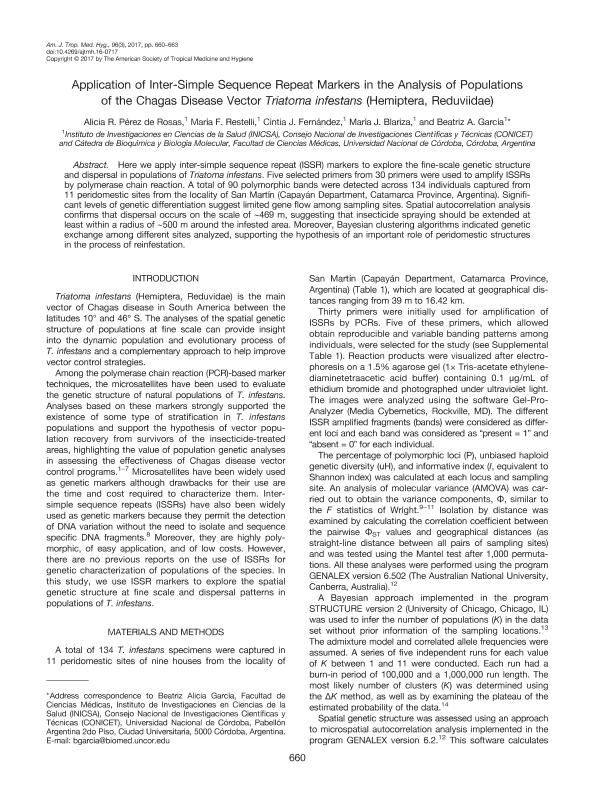Artículo
Application of inter-simple sequence repeat markers in the analysis of populations of the chagas disease vector triatoma infestans (hemiptera, reduviidae)
Perez de Rosas, Alicia Raquel ; Restelli, María Florencia; Fernandez, Cintia Judith
; Restelli, María Florencia; Fernandez, Cintia Judith ; Blariza, María José
; Blariza, María José ; Garcia, Beatriz Alicia
; Garcia, Beatriz Alicia
 ; Restelli, María Florencia; Fernandez, Cintia Judith
; Restelli, María Florencia; Fernandez, Cintia Judith ; Blariza, María José
; Blariza, María José ; Garcia, Beatriz Alicia
; Garcia, Beatriz Alicia
Fecha de publicación:
01/2017
Editorial:
American Society of Tropical Medicine and Hygiene
Revista:
American Journal of Tropical Medicine and Hygiene
ISSN:
0002-9637
Idioma:
Inglés
Tipo de recurso:
Artículo publicado
Clasificación temática:
Resumen
Here we apply inter-simple sequence repeat (ISSR) markers to explore the fine-scale genetic structure and dispersal in populations of Triatoma infestans. Five selected primers from 30 primers were used to amplify ISSRs by polymerase chain reaction. A total of 90 polymorphic bands were detected across 134 individuals captured from 11 peridomestic sites from the locality of San Martín (Capayán Department, Catamarca Province, Argentina). Significant levels of genetic differentiation suggest limited gene flow among sampling sites. Spatial autocorrelation analysis confirms that dispersal occurs on the scale of ∼469 m, suggesting that insecticide spraying should be extended at least within a radius of ∼500 m around the infested area. Moreover, Bayesian clustering algorithms indicated genetic exchange among different sites analyzed, supporting the hypothesis of an important role of peridomestic structures in the process of reinfestation.
Archivos asociados
Licencia
Identificadores
Colecciones
Articulos(INICSA)
Articulos de INSTITUTO DE INVESTIGACIONES EN CIENCIAS DE LA SALUD
Articulos de INSTITUTO DE INVESTIGACIONES EN CIENCIAS DE LA SALUD
Citación
Perez de Rosas, Alicia Raquel; Restelli, María Florencia; Fernandez, Cintia Judith; Blariza, María José; Garcia, Beatriz Alicia; Application of inter-simple sequence repeat markers in the analysis of populations of the chagas disease vector triatoma infestans (hemiptera, reduviidae); American Society of Tropical Medicine and Hygiene; American Journal of Tropical Medicine and Hygiene; 96; 3; 1-2017; 660-663
Compartir
Altmétricas



